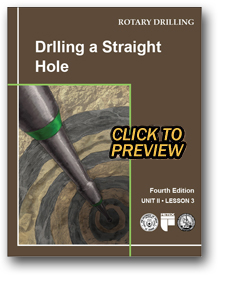Drilling a Straight Hole, 4th Ed.
By Ben Randell
This publication is Lesson 3 of Unit 2 of the Rotary Drilling Series (RDS)
When rotary drilling first began, operators and drillers assumed that if they held the kelly vertical when starting the hole, the drill string and bit would drill a straight hole. During a boom in 1928, however, the industry began to suspect that holes were crooked. On occasion, wellbores actually intersected. In addition, actual drilled depths did not correspond to projected formation depths. Hole deviation could add serious costs to the operator and possibly provide legal problems when wells accidentally drilled onto another lease or into another wellbore. Throughout the years, borehole survey instruments have undergone many refinements to help drill crews keep their well on target.
While horizontal drilling has made great progress in recent years, the principles behind keeping a hole straight and on course are still very important to the work of a rotary rig crew. Bottomhole assemblies have never been more important in drilling a successful hole as they are now. This new edition discusses them at length. MWD techniques have made maintaining a hole on course easier than ever and the book explains that principle as well. Readable language, clearly labeled illustrations and photographs, a glossary, an index and helpful self-test review questions help the reader to comprehend the material. ISBN 0-88698-260-7. 2015, 160 pp.
Please note: All online material will be delivered during PETEX regular business hours, 8:00am-5:00pm CST(UTC -6).
| Format | Price | Catalog No. | |
|---|---|---|---|
| $68.00 | 2.20340 | ||
| E-Book | $58.00 | 2.20340E | |
| Printed book & e-Book Bundle | $83.00 | 2.20340B |






